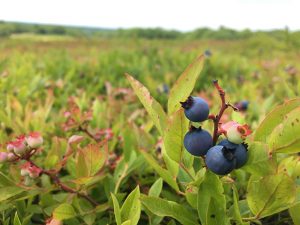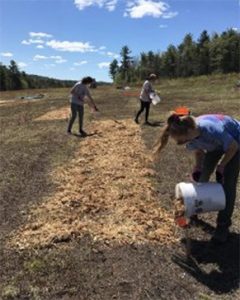Bulletin #2073, Growing Wild Blueberries at Home
By Lily Calderwood, Ph.D., University of Maine Cooperative Extension Wild Blueberry Specialist, and Mara Scallon, Research Assistant, Lowbush Blueberry Research and Extension Program, University of Maine.
For information about UMaine Extension programs and resources, visit extension.umaine.edu.
Find more of our publications and books at extension.umaine.edu/publications/.

Living in Maine offers a range of benefits, stretching from the coasts to the mountaintops to the riversides. One of the most delicious benefits comes in the form of the wild (lowbush) blueberry plant, which is a native and naturally occurring plant in the landscape. Because wild blueberries thrive in Maine it is likely that you already have them in your backyard or could transplant wild blueberries from one location to your equally suitable backyard. This fact sheet is for Mainers looking to foster their own wild blueberry plants at home.
Establishing a new wild blueberry patch
Location
Wild blueberries live in acidic, very well-draining coastal and mountain top locations. Sometimes it seems that wild blueberries grow everywhere in Maine but in order to foster them on your own land, you will need the right conditions because this plant has never been bred for attributes that would make it easier to cultivate. Wild blueberries will not grow well in a garden box, planter, or grown with annual vegetables or other perennial berry bushes. A separate, specific location that provides slightly acidic, well-drained, sandy soil with ample room for the blueberry plant to grow horizontally, while maximizing daily sun exposure will improve the likelihood of successful wild blueberry harvests. These locations may not necessarily be found in the specific place where you would prefer to have wild blueberries, such as close to your house.
Soil
It’s important to plant wild blueberries in well-drained soils, like sandy soils. Do not plant wild blueberries in clay soils. Identify your soil pH by taking a soil sample.
Apply sulfur to decrease the soil pH to 4.0 – 4.5; see wild blueberry fact sheet #254, Soil pH Management for recommendations on applying sulfur. Note that sulfur should not be applied when the ground is frozen or saturated with water or when your wild blueberry leaves are wet as you could burn the wild blueberry leaves.
To sample your soil, pick up a soil sample box and form from your local University of Maine Cooperative Extension County Office, or from the Analytical Lab and Maine Soil Testing Service. Call 207.581.3591. Some garden centers may carry them as well.
Using a trowel or small shovel and bucket, head to the location you’d like to plant wild blueberries and gather multiple samples of soil by digging a few small holes three to six inches deep. Repeat ten times minimum, then mix these soil samples together in a bucket and use the resulting mixture to fill a soil sample box. Mail the box and soil sample form to the Maine Soil Testing Lab in Orono with payment. Please send a check or money order to cover the cost of the analysis. For additional information on testing your soil, see Bulletin #2286, Testing Your Soil
Transplanting
When buying blueberry sod be sure to choose a reputable nursery. Sod is cut from old wild blueberry patches or fields in Maine and usually comes in 1ft x by 1ft, 3-inch thick blocks.
Transplant the sod in the desired location. Wild blueberries can be planted as separate plants, in rows, or mixed in with other plants. Wild blueberries need full sunlight to grow best so you may need to prune nearby plants to maximize exposure to sunlight.
For the first two years of growth, you want wild blueberries to put their energy into re-establishing strong roots, so you must pinch off all blossoms for those first two seasons. Painful as this is to do, it will improve the long-term health of wild blueberries substantially.
Mulch
Apply softwood mulch among sod pieces and in between blueberry stems. This adds organic matter and holds moisture, aiding in wild blueberries’ root development. Softwood mulch is a good choice because it is already a lower pH material and it is readily available in Maine.
Water
Water or irrigate in the first two years so wild blueberries can re-establish well in a dry season. Wild blueberries need approximately one inch of water per week. If watering, don’t provide this water all at once – space it out over the course of the week. If there is adequate rainfall, there is no need to add supplemental water as this can cause disease.
Encouraging an existing wild blueberry patch
Mowing
Mow the wild blueberry patch every other fall (October through November) to 1.5-inch height. To mow, you can use a lawnmower, power trimmer, or flail mower on the lowest setting. Don’t worry, 75% of the plant is underground so you will not hurt the plants. Wild blueberries need to be mowed in order to produce berries in the quantities we want them to.
If you want to produce berries every single year, you’ll need to develop a two-year production cycle. Split your patch in half (approximately) and mow one half of the patch at the end of the season (in October through November), using a lawnmower, electric trimmer, or flail mower). Leave the other half of the patch un-mowed. In the spring, you will see that your mowed patch begins to grow stems and buds and as the season progresses, the stems will grow taller but you will not see any berries. This is known as the “prune year” and the goal is vegetative growth for next year’s berry harvest. The side that was not mowed will produce berries. During the fall after picking the berries, mow this side to produce berries in two years. In short, you will mow half of your patch every year, alternating sides. Berries will be produced every year but on alternating patches.
Burning blueberry plants is another way of pruning the plant, however, this is not recommended for homeowners due to safety reasons.
Water
Wild blueberries need approximately one inch of water per week in both the prune and crop years. If it doesn’t rain frequently, ensure your plants are receiving enough water.
Manage weeds
Maintaining a soil pH between 4.0 and 4.5 reduces competition from grasses and broadleaf weeds. For more information about applying sulfur to maintain acidic soil pH see wild blueberry fact sheet on Weeds. For woody tree saplings (e.g. birch, willow, alder) and ferns (e.g. sweet, bracken), cutting is the best management option. Cut these saplings and ferns to the ground three times each year. The goal is to let the plant put energy into above-ground vegetative growth and then cut it away. Cut the undesired plant in early summer when it has fully leafed out, let the plant grow back again, cut it again, and repeat until the plant stops growing.
General best practices
Fruit harvest & storage
The easiest way to harvest the blueberries is by either hand-picking a small plot, or using a metal hand rake for a larger plot. Homeowners can expect yields of approximately half a pound per square foot once the plant is well established, which usually occurs after four years of good management. As with all fruit, wash the berries before consuming them, and store harvested berries in an open container within your kitchen’s refrigerator to extend the berries’ shelf life. Be sure to enjoy the bounty of your harvest in a range of recipes!
Encourage pollinators!
Wild blueberries are pollinated by many native bee species and managed honey bee hives. Entice pollinators to come to your wild blueberries by planting pollinator-friendly plants that bloom throughout the season. Consider how your use of certain pesticides might adversely impact pollinator populations. For more information see Bulletin #7153, Understanding Native Bees, the Great Pollinators: Enhancing Their Habitat in Maine.
Sunlight
Wild blueberries grow best in full sunlight. If other plants are shading your wild blueberries, you may need to prune or move those plants. Wild blueberry stems will tilt towards the sun when they do not have enough light.
Fertilizer
Keep in mind, fertilizers can feed weeds just as much as wild blueberries so fertilizing is not always needed. Conventional fertilizers for acidic plants contain soluble ammonium sulfate, which allows nutrients to be taken up in the acidic wild blueberry soils. Organic gardeners will want to use products for plants requiring acidic conditions such as those marketed for blueberry and rhododendron.
Troubleshooting
If the plants are not growing or bearing well, start by looking at the following:
- Soils: are they acidic (4.0 – 4.5 pH) and well-drained?
- Sunlight: is there enough?
- Water: is there enough?
For more information
Lily Calderwood
Wild Blueberry Specialist and Assistant Professor of Horticulture
University of Maine Cooperative Extension
lily.calderwood@maine.edu
207.812.2915
Information in this publication is provided purely for educational purposes. No responsibility is assumed for any problems associated with the use of products or services mentioned. No endorsement of products or companies is intended, nor is criticism of unnamed products or companies implied.
© 2022
Call 800.287.0274 (in Maine), or 207.581.3188, for information on publications and program offerings from University of Maine Cooperative Extension, or visit extension.umaine.edu.
In complying with the letter and spirit of applicable laws and pursuing its own goals of diversity, the University of Maine System does not discriminate on the grounds of race, color, religion, sex, sexual orientation, transgender status, gender, gender identity or expression, ethnicity, national origin, citizenship status, familial status, ancestry, age, disability physical or mental, genetic information, or veterans or military status in employment, education, and all other programs and activities. The University provides reasonable accommodations to qualified individuals with disabilities upon request. The following person has been designated to handle inquiries regarding non-discrimination policies: Director of Institutional Equity and Title IX Services, 5713 Chadbourne Hall, Room 412, University of Maine, Orono, ME 04469-5713, 207.581.1226, TTY 711 (Maine Relay System).


